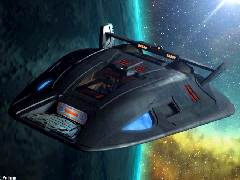Hunley Class Shuttle
Category: Shuttle

Expected Duration: 0 years
Time Between Resupply: 0 years
Time Between Refit: 0 years
Personnel
Crew: 3
Speed
Cruising Velocity: Warp 2
Maximum Velocity: Warp 3.5
Emergency Velocity: Warp 4.7 (for 12 hours)
Dimensions
Length: 17 metres
Width: 14 metres
Height: 4.2 metres
Decks: 1
Armament
Micro-Torpedoes
Micro-Torpedo Launchers: 3
Micro-Quantum Torpedoes: 4
Micro-Photon Torpedoes: 16
Phasers
Type VI Array: 2
Shielding Systems
Light Shielding System
The Hunley can be crewed by three people but only sleeps two. The maximum attainable depth of the Hunley, a figure arrived at after extensive testing, was just under 25 miles, a depth considerably greater than that found on most Class M worlds but which is known to exist on certain worlds. Theoretically, the absolute maximum attainable depth is 30 miles, although critical structural stresses would make this an exceptionally risky option that would, quite likely, result in the shuttle’s implosion. The vessel’s deflector dish can be covered by a retractable panel to reduce drag levels while submerged if preferred.
Description
Following the end of the Dominion war, and the construction and refitting of more science-orientated ships, Starfleet R&D came to the conclusion that with the hugely successful development of the Argo project, it was also the time to develop a craft that was specialized to sub-aquatic missions that could operate independently for similar durations as Danube and Delta Flyer Class runabouts. Starfleet issued a design brief for a small craft that would be able to demonstrate superior atmospheric flying capability with the ability to remain submersed for an indefinite amount of time.
Starfleet R&D considered several designs but finally settled on the promising Hunley Class. The original plans were modified a great deal, sacrificing a high-ability warp drive and components that enabled superior space flight to make way for a highly superior atmospheric flight and sub-aqua craft. With incredible maneuverability due to its shape and engines, a fresh-designed “Aqua-Drive”, the Hunley Class – named after the first combat-capable submarine – was finally chosen to go forward to production in early 2381.
A scientific vessel through and through, it was determined that the ideal crew number for the Hunley was three people. However, as the demands of the new sub-aquatic drive grew, internal space for personnel grew scarce. However, Starfleet felt that the shuttle could only be viably used with three personnel. Therefore, an element of hot-bunking was introduced. On missions when the Hunley operates with three crew members, one will always remain on duty, allowing the remaining two to use the small bunk space located just aft of the cockpit. It is not a perfect solution to the problem but it had proven effective in the past.
Sacrificing sleeping and living space, the Hunley Class features an impressive multi-spectral sensor array that incorporates enhanced receptors located in small packages to either side of the craft’s cockpit area. It also boasts respectable weaponry for a ship of this type and mission. Improving on tried and tested temporary alterations made to other auxiliary craft classes in the field, the new drive incorporates existing submarining engines and conventional impulse technology. This, combined with its design for impressive atmospheric flight skills, creates a craft that can perform tight maneuvers in the resisting confines of a sub-aquatic environment.
The Hunley class features two Type VI phaser banks on the aft crossbar, although these are highly ineffectual over anything but the shortest distances while under water. Unusually, although these are primarily designed for forward fire, they can be fed backwards through a separate set emitters. Coupled with the heat dissipation systems usually found on Type VII phaser banks, this allows a higher-than-average rate of fire for a Type VI bank. The craft also features three torpedo launchers, one of which is located on the underneath of the craft’s leading edge. Two small launchers are located inside the two oval on the aft hull. In another advance from normal tactical engineering, these aft-firing launchers are both self-contained launchers similar to those found on the New Orleans Class and are linked directly with the Hunley’s sub-aquatic drive. Due to the unconventional nature of said drive, power overall consumption is incredibly high. During the design process, Starfleet engineers encountered an energy problem when firing the launchers. When submerged with engines engaged, the power needed to fire the launchers proved so great that the engines would momentarily experience sizable power shortages. Combined with water’s high level of resistance the Hunley was slowed by an unacceptable margin each time the launcher’s fired. To counter this problem, Starfleet installed a set of multiple micro-capacitors that store energy during normal operations and then smoothly and automatically provide power to the engines for the milliseconds it takes to fire the launchers. This provided the same amount of fire at a much reduced energy loss. Since it ultimately became a different type of launcher, Starfleet named it a “Type B”, a launcher just as powerful but uses less energy. It has been thought that the Type B could eventually be fitted onto other craft to provide more firepower at the same energy loss rate but this is just speculation at present, especially due to the nature of the sub-aqua drive and launcher mechanisms. Due to how powerful and power-consuming the engines have to be for the submersible Hunley Class, Starfleet was unable to fit another launcher as it would have taken them back to square one. They fire modified micro-photon and quantum torpedoes and provide excellent protection for such a valuable and unique craft.
The Hunley Class was successfully tried and tested in the Ninth Fleet by Robert Kelargen, the chief architect behind the project, along with much valued assistance from a former Ninth Fleet commanding officer, Darynl Lexer. The Hunley is intended to be employed on all long-range or deep space explorers and all scientific ships. To quote one Obsidian Fleet scientific starship captain, “If you’re looking for new life, you’d check the oceans!”
